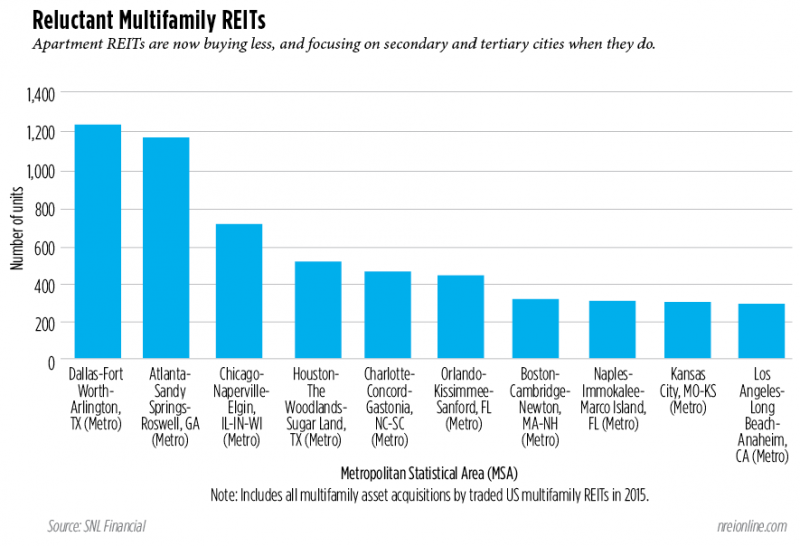Leading apartment REITs are much less eager to bid high on apartment properties than just a few years ago.
“The REITs are simply capturing less of the market today,” says Jim Costello, senior vice president for data firm Real Capital Analytics. “These investors captured roughly 18 percent of all apartment deal volume in the 2010 to 2011 period, but only 5 percent over the last 4 quarters.”
Apartment REITs have a lot of money to spend—if they can find the properties to buy or the places to build. However, the prices of apartment properties are now very, very high in the leading markets favored by many REITs. Those high prices are forcing some leading REITs to scale back. Other REITs have turned to smaller towns in secondary and tertiary markets to buy properties.
Equity Residential slows down
The largest apartment REIT, Equity Residential has scaled back its plans to buy properties in 2015. The company now plans to buy $350 million in apartment properties in 2015—down from its earlier plan to buy $500 million. That’s largely because of heated pricing for multifamily assets. Equity executives noted that cap rates for multifamily buildings are in the 3 percent to 4 percent range in many of its favored markets, during the company’s second quarter earnings conference call.
Strong demand for apartments is making it difficult for REITs like Equity Residential to buy new properties. New investors continue to join the bidding wars to buy, attracted by high occupancy rates and rising rents.
That same strong demand is helping Equity earn money at its existing properties. “Equity Residential continues to benefit significantly from extremely favorable demographics, steady improvement in employment and changing lifestyles,” said David J. Neithercut, Equity Residential’s president and CEO.
The median same-store net operating income earned by apartment REITs—including Equity Residential—continued to trend above 5 percent in 2015, according to SNL Financial. “The fundamentals are still strong,” says Jason Lail, manager of real estate research for SNL Financial. “Increased job growth and household formations have helped demand to outpace supply in most major markets.” Effective rents grew more quickly in the 12 months that ended in the second quarter than any period since 2011, according to data from Axiometrics.
Because of those same strong fundamentals new investors continue to bet on apartment REITs, pushing the stock prices of those REITs higher, and giving those companies the easy ability to raise money—the challenge is finding a way to spend it.
“Year to date, multifamily REITs have outperformed both the broad REIT market and the S&P 500,” says Lail. So far in 2015, U.S. multifamily REITs have provided a total return of 7.4 percent, according to SNL Financial as of July 30. That’s much better than equity REITs overall, which suffered a negative return of -1.4 percent over the same period. It’s also better than the S&P 500, which has earned its investors a positive 3.6 percent return so far this year.
Secondary markets come first
When apartment REITs are able to buy apartment properties, they now tend to spend their money in secondary and tertiary markets and are less likely to buy properties in the largest metro areas. Of the cash REITs spent to buy apartment properties over the year that ended in the second quarter, they only spent 41 percent in the six major markets. That’s down from 63 percent spent in the major markets in 2010 and 2011, according to Real Capital Analytics.
In the last for quarters, REITs spent 57 percent more to buy apartment properties in secondary markets compared to what they spent in 2010 and 2011. REITs spent 103 percent more to buy apartment properties in tertiary markets. But in the six major markets, REITs spent nearly one third less.
“The overall share in the six major metros, though, declined with smaller deal volume,” says Costello.
The top markets where REITs bought apartment properties so far in 2015 start with strong secondary markets, including Dallas-Fort Worth and Atlanta, according to SNL. In 2014, the top markets started with Los Angeles and Seattle.


